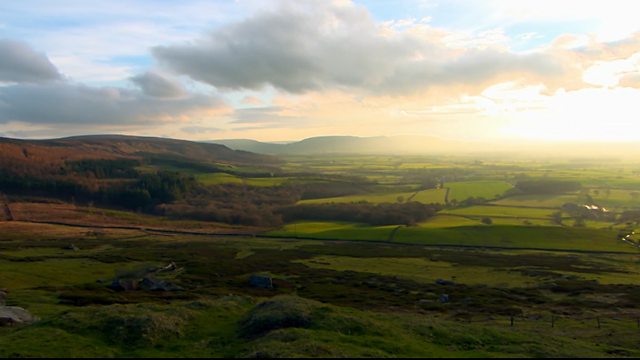Countryfile – Hengistbury Head: Charlotte Smith and Sean Fletcher visit the stunning Hengistbury Head in Dorset, embarking on a journey to explore a vital engineering initiative designed to protect this cherished stretch of coastline from the relentless forces of nature. This large-scale project not only aims to preserve the land but also to rejuvenate the area’s rich historical and ecological tapestry.
At the heart of this initiative is the reconstruction of the Long Groyne, a pivotal breakwater structure that has shielded the coastline for 85 years but now nears the end of its functional lifespan. Sean Fletcher dives into the action, operating a digger alongside the crew tasked with this massive undertaking. He delves into the innovative strategies being employed, including the creation of artificial reefs that promise new habitats for marine life, ensuring biodiversity thrives alongside coastal defense.
During his exploration, Sean meets with a local archaeologist who unveils Hengistbury Head’s fascinating past as a bustling Iron Age port town. This revelation paints a vivid picture of an ancient community that once thrived on these shores, trading extensively with distant lands.
Meanwhile, Charlotte Smith takes a different path, immersing herself in the current natural wonders of Hengistbury Head. She discovers the diverse range of landscapes—from sandy beaches to rugged cliffs—that provide sanctuary to a plethora of species. Charlotte learns about the vital role these habitats play in supporting an array of invertebrates, amphibians, and birds, each contributing uniquely to the ecological balance of the area.
The narrative takes a charming turn as Charlotte encounters the individual responsible for a herd of celebrity goats. These goats are not just local favorites but also heroes in their own right, tasked with the conservation of the cliff faces by naturally managing the vegetation. This sustainable method helps prevent erosion while maintaining the natural aesthetics of the landscape.
Adding a cultural dimension to her visit, Charlotte meets with a local artist who has dedicated over three decades to capturing the shifting moods and seasons of Hengistbury Head. Through his eyes, we see the landscape as a living canvas, continuously transformed by time and nature.
Countryfile – Hengistbury Head
In a separate yet equally compelling story, Adam Henson introduces us to a passionate advocate for wool, an ancient natural resource with modern applications. This wool campaigner is at the forefront of a movement to reinvent wool for contemporary uses, highlighting the sustainable practices that can emerge from traditional materials.
This episode of Countryfile at Hengistbury Head not only showcases the efforts to protect and preserve this historical and natural environment but also celebrates the people and initiatives that breathe life into this part of Dorset. From ancient history to modern conservation, the stories of Hengistbury Head are a testament to the enduring connection between people and place.
The Natural Wonder of Hengistbury Head
Geographic location and significance
Jutting out towards the English Channel from Dorset, Hengistbury Head stands as a sentinel of time and nature. This narrow stretch of land, spanning a mere 432 acres, holds within its boundaries a world of wonder and history. Nestled east of Bournemouth and south of Christchurch Harbour, this headland serves as a natural barrier, protecting the surrounding areas from the full force of the sea.
But Hengistbury Head is more than just a geographical feature. It’s a living, breathing testament to the power of nature and the endurance of ecosystems. As you stand atop its windswept cliffs, you can almost feel the weight of history beneath your feet, whispering tales of ancient civilizations and long-forgotten landscapes.
Diverse ecosystem and wildlife habitats
Hengistbury Head is a kaleidoscope of habitats, each supporting a rich tapestry of life. From the salt-sprayed coastal grasslands to the sheltered mudflats, every inch of this landscape tells a story of adaptation and survival. It’s a place where nature has painted with a broad brush, creating a masterpiece of biodiversity.
Imagine walking through a world where over 500 plant species thrive, their roots anchored in soils that have been shaped by millennia of wind and waves. Picture yourself surrounded by a chorus of birdsong, as 300 different types of feathered friends make their home in this coastal haven. From the tiniest insects to the most elusive mammals, Hengistbury Head pulses with life in every nook and cranny.
Historical importance dating back 12,000 years
As you explore Hengistbury Head, you’re not just walking on land; you’re traversing through time itself. This headland has been a silent witness to human activity for over 12,000 years, stretching back to an era when mammoths still roamed the Earth. It’s a place where the footsteps of our ancestors echo through the ages, leaving behind tantalizing clues to their lives and cultures.
The Iron Age, some 2,500 years ago, saw Hengistbury Head transform into a bustling hub of activity. Archaeological excavations have unearthed a treasure trove of over 25,000 objects, each one a piece of the puzzle in understanding our shared past. These artifacts, from simple tools to intricate jewelry, paint a vivid picture of a thriving community that once called this headland home.
Today, Hengistbury Head stands as a bridge between past and present, nature and human endeavor. It’s a place where the whispers of ancient winds mingle with the calls of modern-day explorers, all set against the timeless backdrop of sea and sky. As we delve deeper into the wonders of this remarkable headland, we’ll uncover the stories written in its rocks, etched in its landscapes, and carried on the wings of its wildlife.
Battling Coastal Erosion: The Long Groyne Project
The critical role of the Long Groyne in coastal defense
Imagine a sentinel standing guard against the relentless assault of the sea. That’s precisely what the Long Groyne at Hengistbury Head represents. This man-made coastal defense structure plays a pivotal role in protecting not just the headland, but the entire stretch of coastline it oversees.
Without the Long Groyne, the very ground beneath our feet would be at risk of disappearing. It’s not just about preserving a scenic viewpoint; it’s about safeguarding homes, livelihoods, and an irreplaceable ecosystem. The Long Groyne acts like a shield, deflecting the full force of the waves and slowing down the natural process of erosion that would otherwise eat away at the coastline.
Reconstruction efforts and engineering challenges
Sourcing materials from France and Norway
Building a structure capable of withstanding the mighty ocean is no small feat. The new Long Groyne project has gone to great lengths – quite literally – to source the best materials for the job. Massive granite boulders, some weighing up to ten tonnes each, have been carefully selected and transported from quarries in Saint-Malo, France.
But that’s not all. The underlayer of the groyne, crucial for its stability, comes from Larvik in Norway. This international sourcing of materials underscores the scale and importance of the project. It’s a testament to the fact that sometimes, to protect our local treasures, we need to think globally.
Moving 34,800 tonnes of rock
Now, picture this: 34,800 tonnes of rock. That’s equivalent to the weight of about 5,800 adult African elephants! This mind-boggling amount of material needs to be moved and precisely placed to form the new Long Groyne. It’s a monumental task that requires not just brute force, but incredible precision and planning.
Giant diggers and massive dumper trucks work tirelessly, moving these colossal rocks into place. It’s like a gigantic, real-life game of Tetris, where each piece must fit perfectly to create a structure that can withstand the immense power of the sea. The new groyne will stand 1.5 meters taller than its predecessor, ready to face the rising sea levels and increased storm activity predicted for the future.
Environmental considerations in coastal protection
Designing for marine life colonization
While the primary goal of the Long Groyne is to protect the coastline, the project team hasn’t forgotten about the marine life that calls these waters home. In fact, they’ve gone above and beyond to ensure that the new structure will actually enhance biodiversity in the area.
Special concrete cubes with nooks, crannies, and pools have been designed to be incorporated into the groyne. These aren’t just random additions; they’re carefully crafted habitats that will retain water during low tide, providing refuge for a variety of marine species. It’s like creating a series of underwater apartments, each designed to attract different tenants from the sea.
Balancing human needs with ecosystem preservation
The Long Groyne project is a prime example of how human intervention can work in harmony with nature. By protecting the coastline, we’re not just saving human structures; we’re preserving vital habitats for countless species that depend on this unique environment.
Moreover, the project demonstrates a forward-thinking approach to coastal management. Instead of simply building a barrier, the team has created a structure that will become an integral part of the marine ecosystem. In time, the new Long Groyne will be colonized by seaweeds, limpets, and a host of other marine life, blending seamlessly into its surroundings while still performing its crucial protective role.
As we witness this massive undertaking, we’re reminded of our responsibility as stewards of the environment. The Long Groyne project shows us that with careful planning and innovative thinking, we can protect our coastlines while also nurturing the natural world that surrounds us. It’s a beacon of hope, standing firm against the tides of change, and ensuring that future generations can continue to enjoy the wonders of Hengistbury Head.
Hengistbury Head: A Living Museum of History and Nature
Archaeological treasures spanning millennia
Palaeolithic hand axe: A glimpse into prehistoric life
Hold your breath as we step back in time, 12,500 years to be exact. Imagine a world where mammoths roamed and early humans fought for survival. In your hand, you’re holding a tangible piece of that distant past – a Palaeolithic hand axe discovered at Hengistbury Head.
This isn’t just any stone tool; it’s the pinnacle of prehistoric technology. Crafted with precision, its design speaks volumes about our ancestors’ ingenuity. The axe fits perfectly in your palm, its edges honed for efficient butchery. As you turn it over, you can almost feel the connection to the ancient hands that once wielded it, a bridge across millennia.
Iron Age artifacts: Evidence of a bustling ancient port
Fast forward 10,000 years, and Hengistbury Head transforms into a thriving hub of commerce. The discovery of an exquisitely preserved Iron Age brooch paints a vivid picture of this era. Its intricate design and craftsmanship reveal a sophisticated society, far from the primitive image often associated with prehistoric times.
But the real showstopper is the amphora handle, a ceramic relic that once adorned massive vessels from the Mediterranean. This seemingly simple object tells a grand tale of international trade, exotic goods, and cultural exchange. Suddenly, Hengistbury Head isn’t just a local landmark; it’s a window into a vibrant, interconnected ancient world.
Biodiversity and conservation efforts
Rare species of moths, birds, and insects
Hengistbury Head isn’t just a treasure trove of history; it’s a sanctuary for an astonishing array of wildlife. As night falls, the air comes alive with the flutter of moth wings. Among them, the elusive sand dart moth, found in only a handful of sites along the coast, calls this place home.
By day, the cliffs buzz with activity. Sand martins, nature’s aerial acrobats, swoop and dive, their nests tucked safely in the sandy banks. Meanwhile, in the freshwater pools, dragonflies and damselflies perform their delicate ballet, their life cycles a testament to the area’s ecological richness.
Innovative approaches to habitat management
Conservation at Hengistbury Head isn’t just about preservation; it’s about innovation. Take, for instance, the unexpected heroes of coastal management – a herd of goats. These four-legged landscapers have been enlisted to tackle invasive species and maintain the delicate balance of the ecosystem.
As the goats munch their way through thick scrub, they’re not just clearing vegetation; they’re sculpting the landscape, creating opportunities for native species to thrive. It’s a brilliant example of how nature, when given the chance, can be its own best caretaker.
The visitor experience: Connecting past and present
Replica Iron Age roundhouse and pottery making
Step into the past as you enter a meticulously reconstructed Iron Age roundhouse. This isn’t just a static display; it’s a living, breathing space that transports you back in time. The smoky aroma, the dim light filtering through the thatched roof – every detail has been carefully considered to create an immersive experience.
But the real magic happens when you get your hands dirty. Try your hand at Iron Age pottery making, feeling the cool clay between your fingers as you shape it into a vessel. As you work, you’re not just creating a pot; you’re forging a connection with the ancient inhabitants of this land.
Nature walks and wildlife observation opportunities
As you step out of the roundhouse and into the present, the natural wonders of Hengistbury Head beckon. Follow winding trails that lead you through a tapestry of habitats, each turn revealing new surprises. Listen for the distinctive call of the Dartford warbler or catch a glimpse of a basking lizard.
For the patient observer, the rewards are endless. Set up near one of the freshwater pools and watch the miraculous life cycle of dragonflies unfold before your eyes. Or join a guided walk to learn about the intricate relationships between plants, insects, and birds that make this ecosystem so special.
Hengistbury Head isn’t just a place to visit; it’s a place to experience. Here, history and nature intertwine, creating a unique tapestry that captivates the senses and ignites the imagination. Whether you’re an archaeology enthusiast, a nature lover, or simply someone seeking a connection with the past and present, Hengistbury Head offers a journey of discovery that will leave you inspired and in awe of the wonders that surround us.
F.A.Q. Countryfile – Hengistbury Head
Q.: What is the purpose of the Long Groyne project at Hengistbury Head?
A.: The Long Groyne project is a critical engineering initiative designed to protect the Hengistbury Head coastline from erosion. The reconstruction of this aged breakwater structure helps maintain the coastline, prevent land loss, and safeguard the habitats that rely on the stability of this area. This project not only aims to reinforce the coast but also ensures the area remains a viable habitat for diverse marine and terrestrial species.
Q.: What unique historical insights does Hengistbury Head offer?
A.: Hengistbury Head is rich in history, serving as a crucial archaeological site that offers insights into its time as a bustling Iron Age port town. This area has revealed over 25,000 artifacts, illustrating its extensive trade relationships and vibrant community life thousands of years ago. The site helps historians and visitors alike understand the dynamic history of human settlement and interaction along this part of the Dorset coast.
Q.: How does the new groyne support local biodiversity?
A.: The design of the new groyne incorporates features like artificial reefs and specially designed concrete habitats that promote marine life colonization. These structures provide new habitats for various marine species, enhancing local biodiversity. By offering refuge and breeding grounds, the groyne contributes to the ecological health and diversity of the coastal and marine environments.
Q.: What kinds of wildlife can be observed at Hengistbury Head?
A.: Hengistbury Head is a haven for a variety of species, including over 300 types of birds, diverse invertebrates, and a range of amphibians. The area’s varied landscapes, from grassy heathlands to sandy beaches and rugged cliffs, create a mosaic of habitats that support rich biodiversity. Seasonal changes bring different species into view, making it a continually fascinating place for wildlife observation.
Q.: What activities can visitors engage in at Hengistbury Head?
A.: Visitors to Hengistbury Head can enjoy a variety of activities that enhance their understanding and appreciation of the area. These include guided nature walks, wildlife observation, and visiting historical exhibits. Educational programs often focus on the area’s archaeological significance and natural heritage, offering hands-on experiences like pottery making and interactive tours of reconstructed ancient dwellings. This mix of educational and recreational activities makes Hengistbury Head a dynamic destination for all ages.
Conclusion: Countryfile – Hengistbury Head
The ongoing balance between conservation and public access
Hengistbury Head stands as a testament to the delicate dance between preserving natural wonders and allowing people to experience them firsthand. As we look to the future, maintaining this balance becomes increasingly crucial. On one hand, we have a responsibility to protect this unique ecosystem and its rich historical heritage. On the other, we must ensure that future generations can still connect with and learn from this remarkable place.
Striking this balance isn’t always easy, but it’s a challenge we must embrace. By implementing thoughtful access policies and educating visitors about the importance of conservation, we can help ensure that Hengistbury Head remains both protected and accessible. After all, it’s through personal experiences that people develop a deep appreciation for nature and history, which in turn fosters a desire to protect these precious resources.
The importance of continued research and monitoring
The story of Hengistbury Head is far from complete. In fact, every day brings new discoveries and insights. Ongoing research and monitoring play a vital role in our understanding and preservation efforts. From tracking changes in wildlife populations to uncovering new archaeological findings, this continuous quest for knowledge helps us make informed decisions about how best to protect and manage the area.
Moreover, research at Hengistbury Head often has broader implications. The lessons learned here about coastal erosion, habitat management, and preserving historical sites can be applied to similar locations around the world. In this way, Hengistbury Head serves not just as a local treasure, but as a global classroom for conservation and heritage management.
Encouraging public engagement and support for preservation efforts
Preserving Hengistbury Head isn’t just the job of scientists, archaeologists, and park managers. It’s a community effort that requires the engagement and support of the public. By fostering a sense of ownership and connection among visitors and local residents, we can create a powerful force for conservation.
There are numerous ways to get involved, from participating in volunteer programs to supporting local conservation organizations. Even simple actions, like following designated paths and properly disposing of waste, can make a significant difference. By educating visitors about these opportunities and the impact of their actions, we can transform casual visitors into passionate advocates for Hengistbury Head’s preservation.
As we look to the future, the fate of Hengistbury Head lies in our hands. It’s up to us to ensure that this remarkable place, with its stunning natural beauty and rich historical legacy, continues to inspire and educate for generations to come. By working together, balancing conservation with access, supporting ongoing research, and actively engaging in preservation efforts, we can safeguard this natural wonder. In doing so, we’re not just preserving a piece of land; we’re protecting a living link to our past and a vital part of our natural heritage. Let’s embrace this responsibility with enthusiasm and dedication, ensuring that Hengistbury Head remains a beacon of nature, history, and community for centuries to come.




